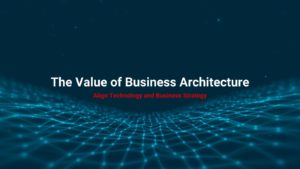Shape the Demand for Business Response & Strategic Value.
This is a critical moment with an opportunity to really change the game – from what’s “important now” to what’s “urgent now and strategic over time”. The external forces and immediate business needs will dictate that you are responsive with some things necessary to scale and support very dynamic short-term business changes. You owe it to the company to keep the bigger, more strategic, and longer-term initiatives and objectives in play – to do no harm for the future.
To do this, ruthless prioritization is critical. This is no time to continue business as usual habits of trying – and probably struggling anyway – to satisfy all incoming business demand. Engage your team and your business leaders to take a hard look at stopping or deferring some things so you can reallocate as many financial and people resources as possible to things that are urgent (maybe call those “tactical business response”) and/or important (maybe call those “strategic initiatives”). Go short and go long – kill everything else that’s just incremental improvement in the middle.
“Go Short” (-Term) and “Go Long” (-Term)
During a crisis, the inertia of the current course and speed is interrupted. The leadership agenda will, no doubt, shift to things that are urgent and critical to sustaining the enterprise. Our customers might require unique support; our supply chains may have to be reshaped; and, or front-line employees will be impacted. All of those activities will require IT support.
If you’re like most other IT organizations, you’re not just fully deployed against existing demand, but you also have a huge, pent-up backlog of projects and enhancements. This is your chance to reshape how scarce resources can be redeployed against evolving business priorities. For that, you need to establish a different filter to clarify your thinking and to help your teammates on the leadership team of your company make the right decisions about the business and technology.
Two things will matter a year from now. You need to free up resources, people, time, money, focus, bandwidth, to focus on answering these two questions.
- First, did your company survive the crisis and help your customers, employees, business partners, and suppliers through the tough times?
- And, second, as it was before this COVID-19 pandemic, are you able to compete going forward in the modern, digital era of continuous change and transformation?
Everything else that you and your team were doing before the crisis is interesting and might someday come back into focus. But, for now, these other things are not as important and should be ruthlessly challenged and probably stopped or at least deferred for another time.
The Urgent: “Go Short” (-Term)
By “going short”, play offense and create an “urgent response” team whose focus and culture is “bring it on”. Think about creating a virtual for now, and later a physical, war room or command center and a daily cadence that is not bureaucratic. Set up the team, the roles, and the process to respond to whatever the designated business leadership team senses needs to be done with and for customers, employees, partners, and suppliers. There’s no doubt that this team will need to take short-cuts and probably create more technical debt. They will have to “win ugly” at times, but “win” is the operative word. We can worry about the “ugly” part later.
The Strategic: “Go Long” (-Term)
The question is where we can get these “urgent response” resources. That’s where the “go long” part of your new demand filtering or demand shaping approach kicks in. The future becomes the next focal point because it’s key to winning when the crisis subsides. Keeping the key transformational programs – like omnichannel, customer data and analytics, supply chain, etc. – going is essential. We may have to slow them down, but completely stopping them will cost years and possibly trigger bigger write-offs. Find a way to protect those investments. Remind your team and your business partners of the bigger picture and sell the idea that the company should come out of this crisis ready to play offense again. Also, work with your most important and strategic external partners – they will probably invest with you, weather the storm with you, and bring important perspectives and skills to this part of your plan going forward.
Most importantly, this continuing commitment to those strategic capabilities, to your originally envisioned digital transformation, is what will ultimately help your company compete and win in the big picture of the modern era.
Freeing Up Resources: Everything In Between is a Target
Therefore, the target for resources is everything in between the urgent and the strategic. Generally, this is where the bulk of the developers and the domain knowledge is and can be immediately be redeployed to your real priorities as I’ve described above. To target the middle to find resources to free up for the “urgent response” and for the “strategic initiatives”, I suggest you focus on two key areas:
- Take a hard look at the baseline, which is always positioned as non-discretionary. However, most of us know that 15%-20% of the base can be up for conversation. Challenge the definition. If we redefine the base as break-fix, required upgrades and patches, and regulatory requirements, you’ll find that what’s left over is a significant amount of small enhancements and mini-projects that should be ruthlessly questioned. Free up those resources that had been considered “baseline”, but that are actually discretionary, and re-focus them on “urgent response” – which will likely require different, more relevant changes to the base of legacy or existing systems that those people know well.
- Simultaneously, you should examine, with your business partners, all of the inflight non-capital enhancement projects. These are probably mostly enhancing specific functional or departmental legacy systems. Most of this work will not really matter to either the “urgent” or the “strategic”. Again, the teams lined up to work on these projects will likely have skills and knowledge that are very important to the “urgent response” or “go short” play you’re setting up.
The Moment is Now
What we’ve found over the decades and many crises is that selling this approach of “GO SHORT”(-TERM) AND “GO LONG”(-TERM)” and killing everything in the middle really can work well in these moments. This can’t be done unilaterally. It will absolutely require strong and aggressive partnerships with leaders from across the business.
I’ve shared what’s worked for me and The Feld Group Institute team over time. You should think about what’s worked for you and your teams in times of crisis – and apply that experience here and now. This COVID-19 crisis, this MOMENT, is something different, huge, external, and global. So, this is yet another big learning moment. As you lead through the next days, weeks, and months, think about what you’re learning that could be filed away and used again someday in the future when you will have other, significant and more localized crises such as a bankruptcy, an acquisition, a big new business initiative gone bad, or just a top-leadership change.
The moment is now. How can you seize the moment to reshape the demand your IT team faces and make sure that the most “urgent” and most “strategic” priorities are your focus?
Author: Charlie Feld, Founder, The Feld Group Institute
Connect with Charlie Feld on LinkedIn ![]()
Photo by Anastasia Petrova on Unsplash




